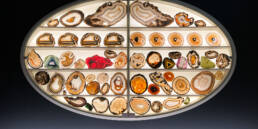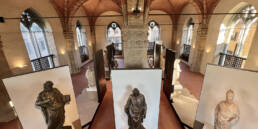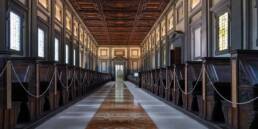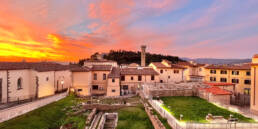Tomás Saraceno, the Argentinian installation artist, architect and thinker (b. 1973) wants us to re-calibrate our relationship with nature. At Palazzo Strozzi in Florence, his solo exhibition Aria (until July 19, 2020) is an immersive experience co-created with spiders that suggests a utopic, if somewhat impractical, new way of cohabitating with plants and animals. He proposes that it’s time to move into a new era, one in which air is the principal theme – the Aerocene. His experiments have more than a few points in common with Leonardo da Vinci’s – from attempting flight without fossil fuels to looking to natural forms as shapes to emulate.

Meanwhile, the artist has also been busy with a commission from Ornellaia, a winery located in the Tuscan area of Bolgheri, for their Vendemmia d’Artista project. In custom labels, large format bottles and a site-specific work, Saraceno touches on similar themes to those found in the Strozzi exhibit, namely the need to pay greater attention to nature. The project aligns perfectly with the winery’s own values of respect for the earth and its inhabitants. In fact, I’m seeing parallels between the way Saraceno works and the role of the winemaker: both guide nature in order to produce a work of art that is co-created between nature and humans.
Saraceno might, in fact, be a modern-day Leonardo: a multi-disciplinary thinker and observer of nature. While Leonardo was ahead of his time, Saraceno’s work fits right into the current apocalyptic zeitgeist with its very tangible global warming and the Coronavirus pandemic that, a few hundred years ago, would most certainly have been understood as divine retribution. And while the general populace stocks up on staples at the supermarket, Saraceno tries to think our way out of the situation.
Saraceno for Ornellaia
My experience of Saraceno’s show at Palazzo Strozzi was a privileged one: I was invited to the presentation of the 2017 vintage of Ornellaia and of Saraceno’s project for the company’s Vendemmia d’Artista project held in the museum’s spaces, after which I had a guided tour of the exhibition. This combination has given me plenty food for thought.
2017 will go down as one of the hottest, driest years on record. I was already working in the wine industry as a social media consultant [see my agency’s work in wine communication] and recall that the photos we took that year all showed dry ground and yellowed plants early in the season. Newly planted vines were struggling to reach the minimal groundwater available through their feeble roots. Everyone feared it would be a terrible year for wine, with tiny, concentrated grapes making for too much sugar and too much skin.

Surprisingly, the 2017 wines I’ve tasted so far haven’t been as bad as everyone had been predicting, and at wineries that are able to adapt to extreme weather conditions, it can prove an interesting, even great vintage. Estate director Axel Heinz presented four Ornellaia vintages made in difficult years from a climate perspective: 2017, 2011 (hot), 2010 (cold and wet), and 2006 (considered one of the best vintages ever). Each year, the winemaker has the challenge of adapting his practises in the vineyard and cellar in response to what the weather throws at him, but the final blend will always be of Cabernet Sauvignon, Merlot, Cabernet Franc and Petit Verdot, in varying percentages.
Heinz observes that “2017 is intuitively a testament to climate change, but actually there is no logical trend [in the climate]; we can only be sure that it will be unpredictable.” He spoke about actions the company is taking to adapt to the generally hotter climate – for example, carrying out winter vine pruning as late as possible to delay bud break – but warned that one can’t go too far with more permanent solutions (such as planting more later-maturing grapes ideal for hot climates) because one never knows if the next year will be cold and rainy.

Sustainability – which we may define as the utmost respect for the earth and the people and animals who inhabit it – is key to winemaking, and that’s the theme of the work Saraceno was commissioned to create for Ornellaia 2017. Each year since 2006, Heinz chooses a character that defines that harvest, and 2017 is Solare – in English, Radiant. His is necessarily a positive interpretation of the year’s extreme heat and sun as generous, but we all know this heat is also a wake-up call. I think Saraceno’s interpretation takes it from there and reminds us that we need to pay attention to and respect the sun, and perhaps adapt to it’s expressions.

Like other artists before him, Saraceno was tasked with creating 111 large-format bottles: 100 double magnums (3 litres), 10 Imperials (6 litres) and a unique 9-litre Salmanazar; these will be sold at auction online through Sothebys starting April 30, 2020. In addition, every case of six bottles of Ornellaia features one special label dedicated to the year’s theme. For the first time ever, these labels are “thermodynamic”: similar to those t-shirts we had in the 1980s that changed colour with our body heat, rubbing this label like an Aladdin’s lamp will magically give it a yellow, hot glow. The 10 Imperials show a full eclipse of the sun in multiple phases, while the work for the Salmanazar, called PNEUMA 4.21×105, features a suspended glass ball captured in black netting. These works, as we will see, fit perfectly into the artist’s current body on display at Palazzo Strozzi and are a unique opportunity for collectors.

Saraceno Aria at Palazzo Strozzi – a review
Arachnophobes beware, there are real spiders in this exhibition, and plenty of spider webs! The artist observes that we are entering the Sixth Mass Extinction, that of invertebrates for whom there are no protective laws. Natural ecosystems, he says, are more and more reduced, “carbon emissions fill the air, particulate matter floats inside our lungs while electromagnetic radiation envelops the earth, dictating the tempo of digital capitalism, in the era of global warming.” We should, thus, listen to the spiders.
The exhibition starts with a white room in which a black, man-made web provides support for geometric forms, partially with mirrored surfaces (see photo at top of this article). These are prototypes for aerosolar sculptures that are able to float around the world, a statement about the irrationality of nationally-imposed borders and who can transit where. Saraceno welcomes us to the new age he calls the Aerocene, where we “become airnomads, moving from Homo economicus to Homo Flotantis, attuned to planetary rhythms, conscious of living with other humans and non‐humans … who float in the air, adrift with the wind, within its elemental being.”
While these forms are irregular, they make me think of the Renaissance’s obsession with geometric forms, represented by Paolo Uccello’s representations of the complex mazzocchio in paint and Leonardo da Vinci’s illustrations for Luca Pacioli’s manuscript on divine proportion. The dodecahedron, for Neoplatonists as well as Greek philosophers, represented the entire universe, while the other Platonic polyhedra represented the four elements: earth (cube), air (octahedron), water (icosahedron) and fire (tetrahedron). Geometric forms have always been seen as related to “man,” and imposing these forms on the things we create (such as centrally-planned churches) were, in the Renaissance, a way of expressing the perfection of the universe (as God created it). Saraceno seems to take a step back to reach the same conclusion: the spider does it better than we do.

We are then asked to get on the same wavelength as spiders by participating in a symphony with them: five threads of spider silk drift and resonate with the air as we cause it to move, amplified thousands of times so we can hear it. If you have the fortune of being in here alone, sitting in the darkness without moving produces a calm, low hum, while numerous passersby cause quite the din.

You’ll think twice about cleaning spiderwebs from the corners of your house after visiting the room full of Webs of At‐tent(s)ion, the artist’s own collection of highly intricate spiderwebs that are preserved in huge glass cases. They are created by one or more combinations of different types of spiders who are encouraged to work consecutively or together. For example, one piece is indicated as such: “Hybrid semi‐social solitary solitary Instrument SAO 66943 built by: a quintet of Cyrtophora citricola ‐ three weeks, a solo Nephila senegalensis ‐ eight weeks, a sextet of Holocnemus pluchei ‐ three weeks, rotated 90°, 2020.”

Having become used to the closed boxes of spiderwebs, you’ll be surprised to learn that Passages of Time is a work in progress by a “daddy-long-legs”, native to Palazzo Strozzi, who has been encouraged to weave a large web intercepted by a stream of light that highlights dust and particle matter in the area. (In case you’re wondering, I read that he summons the spiders with specially calibrated tuning forks, but I haven’t been able to figure out how he convinces the spiders to weave only within the frames he creates.) On the wall is the projection of a video that documents the light emitted by the Large Magellanic Cloud, light that we see with a delay of 163,000 years and so most certainly no longer exists. The display questions what species might still be around to see the end of this film, 163,000 years from now. (My guess? At best, the cockroach.)

A room dedicated to A Thermodynamic Imaginary is perhaps the one closest to the work created for Ornellaia. Stay here for long enough and you will witness an eclipse; only when sun, moon and earth are aligned, “in the absence of light, do we become aware of our scale in the shadow of the cosmos.” Another room contains pens hung from suspended balloons that scribble on paper below as we pass, and the message that everything we do impacts the air around us starts to hammer home.
One project Saraceno is particularly excited about is Aerocene Launch, represented in a video projected at the exhibition entrance containing extracts from a documentary that was also presented at Florence’s Odeon Cinema during opening night. His latest development is a hot air balloon that, in a launch in early 2020, broke six world records and is the most sustainable human flight in the history of aviation. Using just air and the heat of the sun, he was able to make a hot air balloon strong enough to carry an adult woman in the air for 15 minutes. The artist sees this is as a new era of random commuting in which humans migrate where the wind takes them, an idea in part inspired by a certain breed of spiders that, when perceiving too much competition for food in one location, builds a kind of parachute and migrates elsewhere.

Interestingly, the shape of Saraceno’s first flying sculptures, which impressed NASA scientists when he studied there in 2009, echoes that of the parachute invented by Leonardo da Vinci (Codex Atlanticus f.1058v.). This parachute is an octahedron, the shape the Greeks associated with air.

It’s worth reading the artist’s statement on this record-breaking work, posted on Instagram, as he contextualizes his work with the current health emergency: “As coronavirus spreads around the world, now landing in Italy, we are being faced with reminders of our intimate connection with the toxic.”
Art and Wine have long been associated with one another, and Ornellaia’s Vendemmia d’Artista is one of the most interesting projects in recent years to promote this combination. Saraceno, like Leonardo before him, looks to nature for inspiration with regard, in particular, to forms that may provide solutions to man’s questions or problems. Leonardo observed many things that science only developed or proved many years later; in a world in which “progress” has sped up tremendously, perhaps Tomás Saraceno’s thoughts and inventions are not so far from being implemented. Meanwhile, from an artistic point of view, the way that Saraceno guides spiders to create what he displays as works of art is not dissimilar to the way the winemaker and his staff guide plants and grapes to perform for them. Both are “cultural outputs” that use what nature provides, while the results – in this case impressive – depend entirely on human genius.

Visitor Information
Tomàs Saraceno, Aria
Palazzo Strozzi, Florence
February 22 to July 19, 2020
Sign up to receive future blog posts by email
Alexandra Korey
Alexandra Korey aka @arttrav on social media, is a Florence-based writer and digital consultant. Her blog, ArtTrav has been online since 2004.
Related Posts
January 30, 2024
Florence Museum News 2024
January 5, 2024
The Architecture of Michelangelo’s Laurentian Library
July 19, 2023




